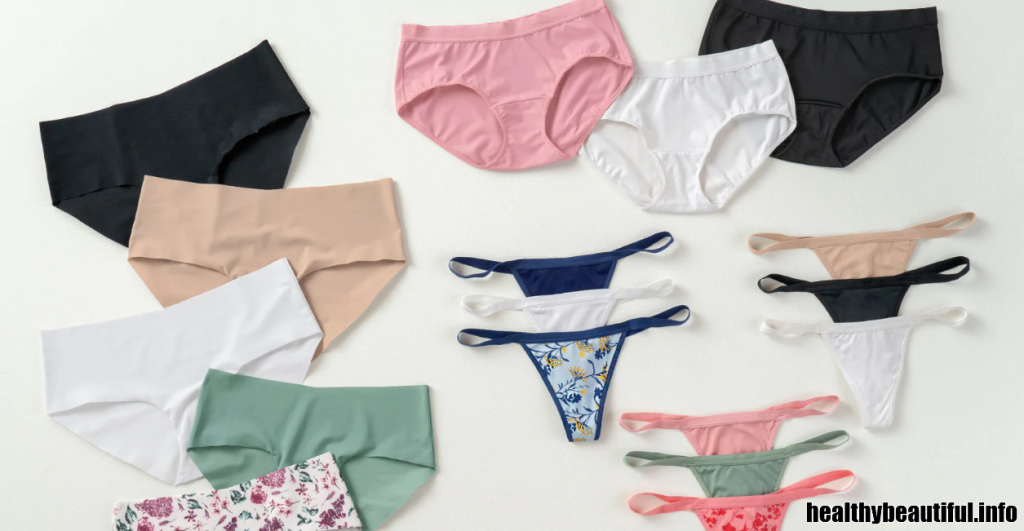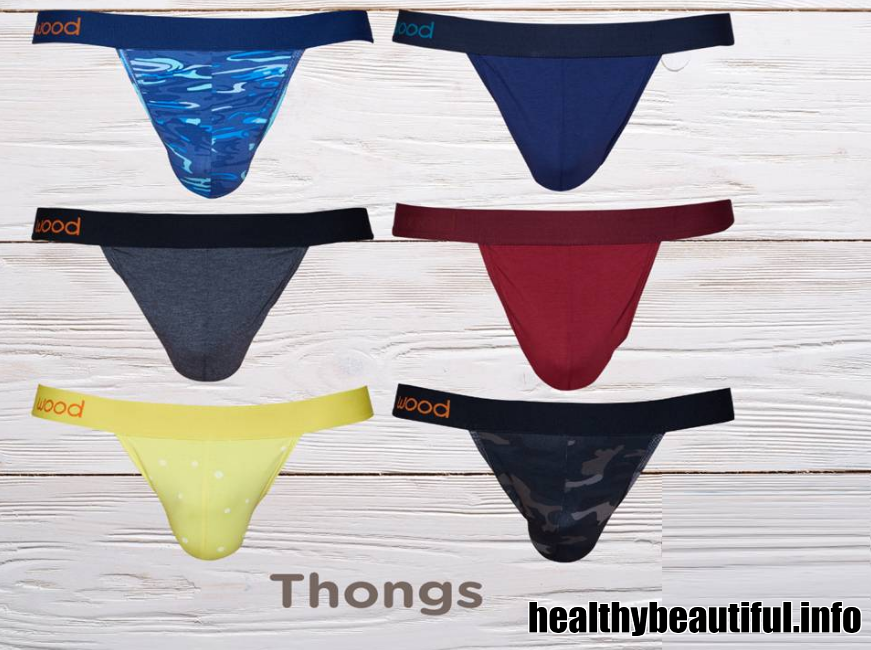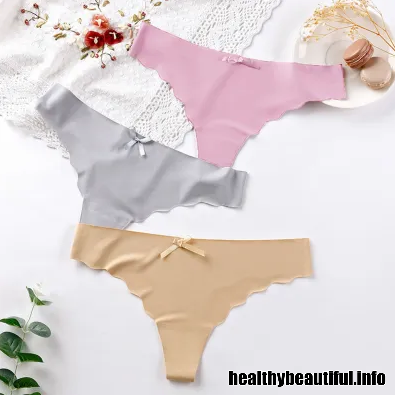Specialists say that tiny undergarments produce serious problems for the health and well-being of women, something very true and proven. Do you want to find out what those dangers might be? Check out the 5 terrible risks of wearing thongs below.
Types of Thongs for Women: Health Implications

Thongs are a type of underwear that is popular among women for their minimalistic design and the absence of visible panty lines. However, wearing thongs can have both benefits and potential health implications. It’s important to choose the right type of thong and practice good hygiene to minimize any potential risks. Here are some common types of thongs and their associated health considerations:
1. Traditional Thong (The Classic): This is the standard thong that you’ve probably seen and worn. It’s got that narrow strip in the back and a little triangular or T-shaped front. But be mindful because sometimes it can cause a bit of chafing – like that annoying rub against your skin that can get pretty uncomfortable. Also, the way it sits can sometimes lead to bacteria from your rear end ending up where you’d rather it not be, which might result in infections.
2. G-String (The Bare Minimum): G-strings are like the next-level thongs – they’ve got even less material, especially in the back. These little things can be super sexy, but they come with their own set of concerns. They offer even less coverage, which means they provide even less protection. You could be at a higher risk of infections with these, and the string part may chafe or irritate your skin.
3. Seamless Thong (The Smooth Operator): Now, the seamless thong is designed to minimize those annoying panty lines and is usually made from softer, more comfortable materials. So, it’s kind of a compromise between style and comfort. Health-wise, it’s like the traditional thong but may be a bit kinder to your skin.
4. Cotton Thong (The Breathable Choice): Cotton thongs are your safest bet in terms of materials. They’re breathable and comfortable. They can help reduce the risk of infections and discomfort, thanks to their natural fibers.
5. Period Thong (The Period Pal): For those days of the month, there are thongs designed especially for your period. They have special layers to absorb, but remember to change them regularly to avoid any unwanted odors and potential issues.
6. Lace or Fancy Thong (The Stylish Choice): These thongs can be super cute with their lace and fancy designs, but the lace might not be as kind to your skin. It could trap moisture and cause irritation or even infections.
To keep things in check and minimize potential issues:
- Make sure your thong fits comfortably and isn’t too tight; you don’t want it to rub you the wrong way.
- Keep it clean by changing and washing your thong regularly.
- Don’t wear thongs every single day; give your body a break.
- If you ever feel persistent discomfort, weird discharge, or any other issues, reach out to a healthcare pro. Remember, our bodies are all different, so what works for one person might not work for another.
Types of Thongs for Men: Which Are Riskiest?

Thong underwear for men is a niche style choice and, like any type of underwear, there can be varying levels of comfort and risk associated with different types. Thongs for men are generally considered to be riskier in terms of potential health implications compared to more traditional styles like boxers or briefs. Here are some common types of men’s thongs and their associated risks:
1. Traditional Men’s Thong (The Classic Choice): So, picture your regular thong, but designed for guys. It’s got that narrow strip running down your backside and a front pouch. Just like with women’s thongs, these can cause chafing and irritation down there, and because of their design, they can bring your backside and front bits into closer contact, which might increase the risk of infections.
2. G-String for Men (The Bare Essentials): G-strings for men take things a step further. They’ve got minimal fabric in the back and a tiny front pouch. They look sexy, no doubt, but they offer even less coverage. This means they can be even riskier when it comes to infections and that thin string at the back can lead to chafing and discomfort.
3. Enhancing or Erotic Thong (The Show-Off): These are thongs designed to enhance the look of your manhood. They often have minimal fabric in the front. Now, these may not be the most comfortable for everyday wear, and the minimal fabric and close fit can also up the risk of infections. But hey, they’re more about style than daily comfort.
The riskiest type of men’s thong really comes down to what you’re comfortable with. G-strings and the more revealing styles are riskier for everyday wear because they offer less coverage and can be less comfy. Traditional thongs might be a bit more comfortable, but they’re not without their risks either, especially in terms of chafing and potential infections.
Ultimately, it’s your call. If you ever feel discomfort, irritation, or anything out of the ordinary, it might be a good idea to switch to regular underwear for everyday wear and save the thongs for special occasions or when you’re in the mood to show off a bit. Your comfort and health should always come first.
The Top 5 terrible risks of wearing thongs
Facilitate the transport of bacteria
The thong for being too tight clothing, facilitates the transport of fecal bacteria into urinary passages, thus causing infections. Lisa Masterson, an American health and wellness gynecologist says: “Rectal bacteria can easily make their way into the vagina just by wearing a thong.”
The obstetrician Angélica Illescas in turn says that the constant rubbing of the garment with respect to the anus and the vagina is constant , reason why it generates microorganisms that can cause very severe damages with the time.
They cause tears
External tears are also often one of the disadvantages of wearing thong. The problem may also be internal. Specialist Kristie Leong says the following: “When a woman walks for a long time using a thong, the material rubs the urethra and the vaginal area creating small tears and irritations. In some cases it can even create an infection. “
They can cause hemorrhoids
According to Lisa Masterson, there are many people who, because of the use of thongs, have suffered hemorrhoids, since they can cause anal inflammations if they have sensitive skin, something that many women suffer today, which can alter the health and well-being of the woman.
Facilitate irritation of the clitoris
Health doctor and Fox News contributor Manny Alvarez said many of his patients have turned to his office because the thong has caused them to feel clitoral irritation, something very real and being present as a disadvantage when using this clitoris. garment.
May produce strong infections due to fungi
Infections due to fungi may also be present if thong is worn for long periods. Kristie Leong says that if you get one of these infections, it could be a very serious danger.
Finding the Best Type of Thongs to Wear for Your Well-being
| Consideration | Description |
|---|---|
| 1. Material | Choose thongs made from breathable, natural materials like cotton to reduce moisture buildup and minimize the risk of irritation and infections. Avoid synthetic materials that trap heat and moisture. |
| 2. Fit | Ensure a proper fit that is snug but not too tight. Tight thongs can lead to chafing and discomfort. Avoid thongs that dig into the skin or leave marks. |
| 3. Hygiene | Practice good hygiene by changing your thong daily and washing them regularly to prevent bacterial overgrowth and odors. |
| 4. Seamless Design | Consider seamless thongs to minimize visible panty lines and reduce the risk of chafing and irritation caused by seams. |
| 5. Moderation | Avoid wearing thongs every day. Give your body a break by wearing other types of underwear, like boyshorts or briefs, to provide more coverage and comfort. Reserve thongs for special occasions or when panty lines need to be minimized. |
| 6. Period-Specific | Use period-specific thongs with absorbent layers during menstruation. Change them regularly to prevent odors and potential infections. |
| 7. Listen to Your Body | Pay attention to any discomfort, itching, unusual discharge, or signs of infection. If you experience these symptoms, consult a healthcare professional. |
| 8. Balance Style and Comfort | Choose thongs that balance style and comfort based on your activities and personal preferences. Prioritize comfort and well-being for everyday wear. |
Finding the best type of thongs to wear for your well-being is crucial. Thongs can be comfortable and stylish when chosen carefully. Here are some tips to help you select the right thongs that prioritize your well-being:
1. Prioritize Soft and Breathable Fabrics: Think about choosing thongs that feel super soft on your skin, like cotton. It’s like wearing your comfiest T-shirt but in underwear form. These fabrics keep you feeling fresh and avoid any sweaty discomfort.
2. Find Your Perfect Fit: Imagine your thongs as your favorite pair of sneakers – they need to fit just right. Not too tight, not too loose. A comfy fit means no pinching, digging, or uncomfortable tugging.
3. Freshness is Key: Keeping things fresh down there is a no-brainer. Change your thongs daily and give them a regular wash. It’s like changing your socks – you wouldn’t wear the same pair for days, would you? This helps keep odors and bacteria at bay.
4. Say Goodbye to Annoying Lines: Ever had a pair of jeans that left a mark around your waist? Seams on your thongs can be just as annoying. So, go for the seamless ones to avoid rubbing and irritation.
5. Thong Breaks: Just like you need a break from work, your body needs a break from thongs. Don’t wear them every day. When you’re hanging out or doing everyday stuff, consider other underwear options for extra comfort.
6. Period-Ready Thongs: For that time of the month, think of your special period thongs as superheroes. They’re equipped with extra layers to tackle any unexpected leaks. But, similar to a superhero, they need a change to stay fresh and avoid any bad smells.
7. Trust Your Body’s Signals: Your body knows best. If something feels off, like itching, discomfort, or unusual discharge, it’s like your body’s way of saying, “Hey, something’s not right.” Don’t hesitate to consult a healthcare pro if you’re concerned.
8. Style That Suits You: Your style is your personal signature. While stylish thongs can be fun, they shouldn’t come at the expense of your comfort and well-being. Mix and match, choosing styles that match your daily activities and personal tastes.
In the end, it’s all about feeling great, confident, and healthy in your choice of thongs. What works for one person may not work for another, so trust your own comfort and style instincts.

Conclusion
The thongs can be a very attractive garment, although in turn they can alter too much the health and the well-being of the girls who like to use them. In view of this it is recommended not to use them for long periods of time and should be avoided in places where sweating is involved or in hot climates.
FAQ
Can wearing thongs lead to health issues?
While it’s not common, there is a risk that wearing thongs may contribute to health problems. Thongs can potentially increase the risk of urinary tract infections (UTIs) and vaginal infections because the thin strip of fabric can allow bacteria to move from the rectal area to the vaginal or urethral area. However, this risk is relatively low and varies from person to person.
Are there risks of skin irritation from wearing thongs?
Yes, the constant friction of a thong against the skin in the buttocks area can lead to skin irritation, chafing, and even skin conditions like folliculitis or intertrigo. Skin irritation can be painful and uncomfortable.
Can wearing thongs cause discomfort or nerve compression?
Prolonged or uncomfortable thong wear can lead to discomfort and pressure on the nerves in the buttocks, potentially causing discomfort or even tingling and numbness in the lower back or legs.
Do thongs worsen or cause hemorrhoids?
For individuals with a history of hemorrhoids or those prone to developing them, thongs can potentially worsen the condition. The pressure and friction from the thong can exacerbate hemorrhoids or contribute to their formation.
Can thongs cause back or hip pain?
Some people may experience back or hip pain while wearing thongs, especially if the thong is too tight or rides up, which can alter the natural curvature of the spine. However, not everyone will experience these issues.
How can I minimize the risks of wearing thongs?
To minimize potential risks, consider the following:
1-Choose thongs made from breathable, moisture-wicking fabrics like cotton.
2-Opt for the right size to ensure a proper fit without tightness or excessive pressure.
3-Avoid wearing thongs during activities that may lead to increased friction or irritation.
4-Pay attention to hygiene and change your underwear regularly, especially if you’re prone to infections.
Can wearing thongs cause health issues, such as infections?
Yes, thongs can increase the risk of bacterial and yeast infections, especially when moisture and friction are trapped in the genital area. This can lead to irritation and discomfort.
Do thongs cause skin irritation or chafing?
Thongs can cause skin irritation and chafing, particularly in the area where the thong string or fabric comes into contact with the skin. This can be uncomfortable and painful.
Can wearing thongs contribute to urinary tract infections (UTIs)?
Some experts suggest that thongs may increase the risk of UTIs by allowing bacteria from the anal area to come into contact with the urethra. However, the link between thong underwear and UTIs is not definitively proven.
Are there any risks of ingrown hairs associated with wearing thongs?
Wearing thongs can increase the risk of ingrown hairs, especially in the bikini area. The tight fit and friction of the thong against the skin can lead to ingrown hairs, which can be painful and unsightly.

